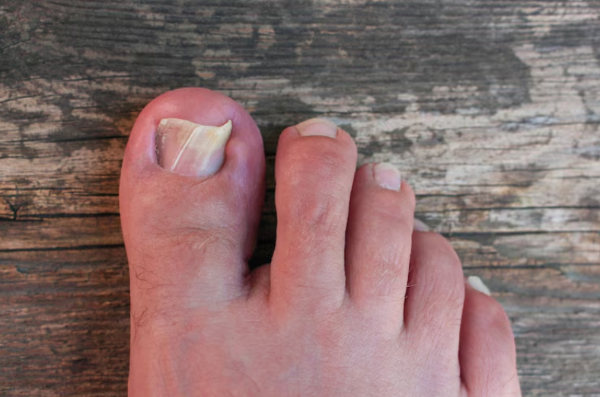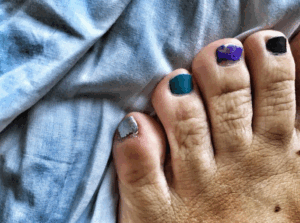Gentian Violet for Toenail Fungus
Gentian Violet for Toenail Fungus: A Comprehensive Guide

Toenail fungus, medically known as onychomycosis, is a common yet often frustrating condition that affects millions of people worldwide.
The unsightly appearance, coupled with discomfort, can be a source of embarrassment for many. Fortunately, there are several treatments available to help combat this condition. One such remedy is gentian violet, a time-tested and natural solution that has been used for decades.
In this article, we will explore how gentian violet can be used to treat toenail fungus, its benefits, and any precautions you should take when using it.
What Is Gentian Violet?
Gentian violet, also known as crystal violet, is a synthetic dye that has been widely used in medicine for over a century.
Originally derived from coal tar, this deep purple dye has a broad range of uses, from staining biological samples in laboratories to treating various fungal infections.
Gentian violet is known for its antifungal, antibacterial, and antiseptic properties, making it effective in treating conditions like toenail fungus, oral thrush, and other superficial infections.
In the case of toenail fungus, gentian violet works by penetrating the nail and its surrounding tissues to target the fungal cells, inhibiting their growth and spread.
It’s worth noting that while gentian violet can be effective, it may not be a one-size-fits-all solution. It’s often used as part of a broader treatment plan.
How Does Toenail Fungus Develop?
Toenail fungus occurs when fungi, often dermatophytes or yeasts, infect the toenails. This can happen when your feet are exposed to warm, moist environments, such as public showers, swimming pools, or sweaty shoes.
The fungi thrive in these conditions and can easily infiltrate the nail bed, leading to an infection. Symptoms of toenail fungus include:
- Thickened, discolored nails (often yellow, brown, or white)
- Brittle or crumbling nails
- A foul odor emanating from the affected area
- Pain or discomfort when pressure is applied to the nail
- A slight separation of the nail from the nail bed
Toenail fungus can be difficult to treat, particularly when it becomes chronic.
Over-the-counter antifungal creams, oral medications, and other topical treatments are available, but these may take time and come with potential side effects. This is where gentian violet comes in as an alternative.
How Does Gentian Violet Work Against Toenail Fungus?
Gentian violet’s effectiveness against toenail fungus can be attributed to its powerful antifungal properties. When applied to the affected toenail, gentian violet penetrates the nail plate and disrupts the cellular function of the fungi.
It prevents the fungi from growing and multiplying by damaging their cell membranes. The dye’s ability to kill a wide range of fungi, including dermatophytes, is one reason why it’s often recommended for treating toenail fungus.
Furthermore, gentian violet works as an antiseptic and antibacterial agent. It can also help prevent secondary bacterial infections, which can sometimes occur in cases of untreated fungal infections.
This is particularly beneficial for people whose toenail fungus is accompanied by irritation or open sores.

Benefits of Using Gentian Violet for Toenail Fungus
- Effectiveness Against a Variety of Fungi: Gentian violet is effective against multiple strains of fungi that commonly cause toenail infections. This includes dermatophytes, yeast, and molds, which makes it versatile in addressing the root cause of the infection.
- Natural Antiseptic: As a naturally occurring antiseptic, gentian violet helps reduce the risk of bacterial infections that may occur along with the fungal infection.
- Affordable and Accessible: Gentian violet is generally inexpensive compared to other over-the-counter antifungal medications. It can often be found in pharmacies or online, making it an easily accessible option for people seeking an affordable treatment.
- No Known Systemic Side Effects: When used topically, gentian violet does not usually produce systemic side effects. Unlike oral antifungal medications that can cause liver damage or digestive issues, gentian violet is applied directly to the infected nail, limiting any risk of systemic side effects.
- Fast Results in Some Cases: While the effectiveness of gentian violet can vary depending on the severity of the infection, many people report seeing improvements in the appearance of their toenails after just a few weeks of use.
- Minimal Risk of Resistance: Fungal resistance to treatment is a growing problem with many antifungal drugs. However, gentian violet does not appear to carry a significant risk of fungal resistance, making it a reliable long-term option for treatment.
How to Use Gentian Violet for Toenail Fungus?
If you decide to use gentian violet to treat your toenail fungus, it’s important to follow proper application instructions to get the best results. Here’s a step-by-step guide on how to use it:
- Prepare the Toenail: Before applying gentian violet, make sure the infected toenail is clean and dry. You may want to soak your feet in warm, soapy water for 10-15 minutes to soften the nails and remove any debris. Afterward, dry your feet thoroughly, paying particular attention to the areas around the nails.
- Apply Gentian Violet: Using a clean cotton swab or a small brush, apply a thin layer of gentian violet directly onto the affected toenail. Be careful to only cover the infected nail and avoid getting the dye on surrounding skin, as it can stain. Some people prefer to apply it to the skin surrounding the nail as well to help treat any fungal growth that may have spread to the skin.
- Allow to Dry: Let the gentian violet dry completely. It may take a few minutes, and during this time, try to avoid contact with clothing or sheets, as gentian violet stains fabric. Once dry, the dye should form a thin purple layer on the nail.
- Repeat the Application: Apply gentian violet once or twice daily, depending on the severity of the infection. It is essential to be consistent with your application to achieve the best results.
- Monitor Your Progress: Over time, you should begin to notice improvements in the appearance of the toenail. The discoloration and thickness may gradually decrease as the fungus is eliminated. Continue the treatment until the infected toenail has grown out completely, which can take several months.
Precautions When Using Gentian Violet
While gentian violet is generally safe to use, there are a few precautions to keep in mind:
- Staining: One of the most noticeable side effects of gentian violet is its ability to stain skin and clothing. The purple dye can leave stubborn stains, so it’s important to protect your clothing, towels, and bedding when using gentian violet. If you accidentally spill gentian violet on fabric, immediately treat the stain with soap and water, but know that it may be difficult to remove completely.
- Skin Irritation: Some people may experience mild skin irritation when using gentian violet, especially if they have sensitive skin. If you notice redness, itching, or a rash, stop using the product and consult a healthcare provider. It’s also important to avoid applying gentian violet to open wounds or cuts.
- Avoid Contact with Eyes: Be careful not to get gentian violet in your eyes. If it happens, rinse immediately with plenty of water.
- Not Recommended for Pregnant or Breastfeeding Women: Although gentian violet is generally considered safe, it is not recommended for pregnant or breastfeeding women due to limited safety data. If you are pregnant or nursing, it’s best to consult your doctor before using gentian violet.
- Consult a Doctor: While gentian violet can be effective for mild cases of toenail fungus, severe infections or cases that don’t improve with home treatment may require a stronger antifungal medication. Always consult a healthcare provider if the infection persists or worsens.
When to Seek Professional Help?
Although gentian violet is a safe and effective option for many people, there are situations where you may need to seek professional medical advice:
- Persistent Infection: If the toenail fungus does not improve after a few weeks of treatment with gentian violet, or if it seems to worsen, you should see a doctor. A healthcare professional may prescribe stronger antifungal medications or recommend a different treatment.
- Pain or Discomfort: If you experience significant pain, swelling, or other symptoms like redness or discharge from the infected area, it’s important to consult a healthcare provider, as these may indicate a more serious infection.
- Underlying Health Conditions: People with compromised immune systems or other health issues, such as diabetes, should consult a doctor before using any antifungal treatments.
Conclusion
Gentian violet is an effective, affordable, and widely accessible treatment for toenail fungus. Thanks to its antifungal and antiseptic properties, it can help eliminate the infection and restore the health of your nails.
While it may not be the solution for everyone, many individuals find success with gentian violet, especially for mild to moderate cases of toenail fungus.
As with any treatment, it’s important to follow the instructions carefully and be patient. Toenail fungus can take time to resolve, but with consistent use of gentian violet, you can expect to see improvements.
While it may not be suitable for everyone, with proper application and precautions, gentian violet can be a valuable part of a comprehensive toenail fungus treatment plan. Always consult a healthcare provider for persistent or severe cases to ensure the best results.

.